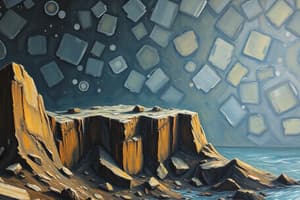Podcast
Questions and Answers
What are comets primarily composed of?
What are comets primarily composed of?
- Solid rock and minerals
- Gas and vapor
- Ice, dust, and metals (correct)
- Rock and metal
From where do long-period comets originate?
From where do long-period comets originate?
- The Oort Cloud (correct)
- The Main Asteroid Belt
- The Roche Limit
- The Kuiper Belt
What is a meteoroid?
What is a meteoroid?
- A fragment that survives the atmosphere
- A bright streak of light from burning debris
- A comet that approaches the sun
- Space debris possibly from asteroids or comets (correct)
What defines a meteor?
What defines a meteor?
What term is used for bright meteors that appear to explode?
What term is used for bright meteors that appear to explode?
What defines an active fault?
What defines an active fault?
What characterizes a deep-focus earthquake?
What characterizes a deep-focus earthquake?
Which statement about seismic waves is accurate?
Which statement about seismic waves is accurate?
What results from the elastic rebound theory?
What results from the elastic rebound theory?
What is a primary characteristic of Love waves?
What is a primary characteristic of Love waves?
What phenomenon can tsunamis cause?
What phenomenon can tsunamis cause?
What type of fault allows rocks to move past each other without vertical displacement?
What type of fault allows rocks to move past each other without vertical displacement?
What is the purpose of the Intertropical Convergence Zone (ITCZ)?
What is the purpose of the Intertropical Convergence Zone (ITCZ)?
Flashcards
Earthquake
Earthquake
A vibration of Earth's surface caused by the sudden release of energy.
Fault
Fault
A crack in Earth's crust where rocks move past each other.
Seismic Wave
Seismic Wave
Energy waves traveling from the earthquake focus through Earth.
Focus (Hypocenter)
Focus (Hypocenter)
Signup and view all the flashcards
Epicenter
Epicenter
Signup and view all the flashcards
Shallow-Focus Earthquake
Shallow-Focus Earthquake
Signup and view all the flashcards
Primary (P) Wave
Primary (P) Wave
Signup and view all the flashcards
Typhoon
Typhoon
Signup and view all the flashcards
Comet
Comet
Signup and view all the flashcards
Kuiper Belt
Kuiper Belt
Signup and view all the flashcards
Oort Cloud
Oort Cloud
Signup and view all the flashcards
Asteroid
Asteroid
Signup and view all the flashcards
Meteoroid
Meteoroid
Signup and view all the flashcards
Study Notes
Earthquakes and Faults
- Earthquake: Rapid release of energy causing Earth's vibration, and ground shaking from fault movement.
- Fault: Crack in Earth's crust with rock movement along it.
- Fault Types: Reverse, normal, strike-slip, oblique.
- Elastic Rebound Theory: Explains energy storage and release causing fault movement.
- Active Faults: Show earthquake activity within the past 10,000 years.
- Inactive Faults: Show no recent earthquake activity.
- Fault Movement Effects: Strong ground motion, landslides, rockfalls, ground ruptures.
- Focus (Hypocenter): Point inside Earth where seismic waves originate.
- Epicenter: Location on Earth's surface above the focus.
- Shallow-Focus Earthquakes: Occur within 100 km of the surface; more destructive.
- Deep-Focus Earthquakes: Rare, less than 3% of earthquakes.
- Earthquake Hazards: Tsunamis from underwater fault movements.
Seismic Waves and Earth's Layers
- Seismic Waves: Energy from the focus causing earthquakes; used to study Earth's interior.
- Body Waves: Travel through Earth's interior.
- P-Waves: Fastest, travel through solids, liquids, and gases.
- S-Waves: Slower, travel only through solids.
- Surface Waves: Travel along Earth's surface.
- Love Waves: Horizontal ground motion, damages building foundations.
- Rayleigh Waves: Ripple-like motion, similar to ocean waves.
- Wave Travel Insights: P-wave velocity decreases in liquids. S-waves do not pass through the outer core (liquid).
Typhoons and Weather Phenomena
- Tropical Cyclones: Systems of thunderstorms with spiral clouds.
- Types: Typhoons (Northwest Pacific), Hurricanes (North Atlantic/Eastern Pacific), Cyclones (Indian Ocean/Bay of Bengal).
- Typhoon Impacts: Strong winds, heavy rain, floods, landslides, storm surges, tornadoes.
- PAR (Philippine Area of Responsibility): Region monitored by PAGASA for typhoons.
- Intertropical Convergence Zone (ITCZ): Area near the equator where trade winds meet, forming cyclones.
- Storm Surge: Abnormal sea-level rise from tropical cyclones.
- Typhoon Tracking: 5-7 day predictions of movement and strength.
- Factors Weakening Cyclones: Land interaction (e.g., Sierra Madre), cold water.
- Public Storm Warning Signals: Alerts about incoming disturbances.
Solar System and Celestial Objects
- Comets: "Dirty snowballs" of ice, dust, and metals. Develop tails near the sun (gas and dust pushed by solar wind).
- Origins: Kuiper Belt (short-period comets), Oort Cloud (long-period comets).
- Asteroids: Minor planets originating from the asteroid belt between Mars and Jupiter.
- Meteoroids, Meteors, Meteorites:
- Meteoroid: Space debris.
- Meteor: Streak of light from a meteoroid burning up in the atmosphere.
- Meteorite: Meteoroid surviving and hitting Earth.
- Fireballs: Bright meteors; exploding fireballs called bolides.
Studying That Suits You
Use AI to generate personalized quizzes and flashcards to suit your learning preferences.




